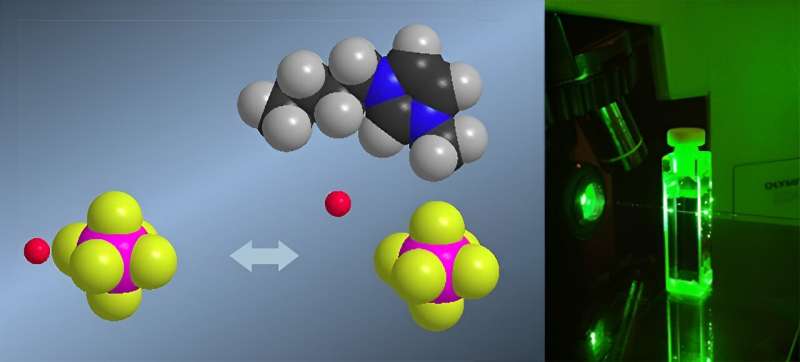This article has been reviewed according to Science X's editorial process and policies. Editors have highlighted the following attributes while ensuring the content's credibility:
fact-checked
peer-reviewed publication
trusted source
proofread
Raman spectroscopy offers new insights into ionic liquid acidity

Researchers at the University of Liège have for the first time determined the acidity of ionic liquids using Raman spectroscopy, thanks to Hammett acidity functions. This advance promises to revolutionize our understanding and use of these organic solvents, in which dissolved acids can be remarkably more acidic than in water, with an acidity that can be up to 100 million times greater.
Ionic liquids, composed of organic salts and liquid at room temperature, have a lower proton solvation, which makes these protons more active and therefore more acidic. Conventional pH measurement is not possible in these solvents, so Hammett acidity functions, based on the protonation of weak bases in acidic solutions, are used.
However, the traditional UV-visible spectroscopy method has its limitations, notably the need for optically transparent media and the use of colored indicators that can interact with ionic liquids, distorting the measurements.
A new article published in Physical Chemistry Chemical Physics presents an innovative method using Raman spectroscopy to measure Hammett acidity functions in three aprotic ionic liquids based on the cation 1-n-alkyl-3-methylimidazolium coupled to the anion bistriflimide.
"Unlike UV-visible spectroscopy, Raman spectroscopy does not require perfectly transparent media or colored indicators, thus eliminating potential sources of error," explains Aurélie Rensonnet, a researcher at University of Liège.
"The measurements we obtained using Raman spectroscopy confirmed the possibility of determining the acidity functions in the ionic liquids studied. These results provide a better understanding of acidity-sensitive chemical reactions in these complex media and open up new prospects for the in-situ characterization of pH-sensitive chemical processes."
This pioneering study makes it possible to experimentally estimate the energy required to transfer protons from water to ionic liquids. These results can be compared with developments in computational chemistry by other research teams, providing a valuable tool for modeling these complex media.
"The potential applications are many and varied," explains Cédric Malherbe, researcher at ULiège and co-author of the publication. "Understanding the super-acidity of ionic liquids is crucial for their use in acid-catalyzed processes, as stable electrolytes in batteries or for the depolymerization of lignocellulosic waste from biomass, with a view to its recovery."
By paving the way for new methods of measuring acidity in ionic liquids, this study marks a significant advance in the field of ionic solvent chemistry. The research prospects and promising industrial applications reinforce the importance of this innovation for years to come.
More information: Aurelie Rensonnet et al, Experimental determination of solvation free energy of protons in non-protic ionic liquids using Raman spectroscopy, Physical Chemistry Chemical Physics (2024). DOI: 10.1039/D3CP04741E
Journal information: Physical Chemistry Chemical Physics
Provided by University de Liege





















